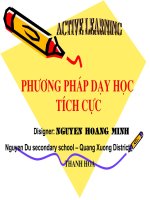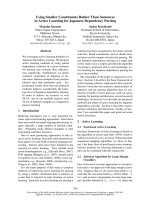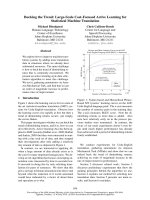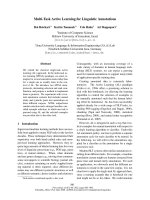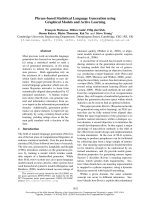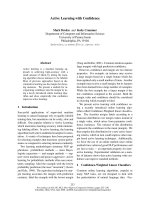Active learning
Bạn đang xem bản rút gọn của tài liệu. Xem và tải ngay bản đầy đủ của tài liệu tại đây (5.05 MB, 45 trang )
<span class='text_page_counter'>(1)</span>Ac#ve Learning Aarti Singh Machine Learning 10-601 Dec 6, 2011 Slides Courtesy: Burr Settles, Rui Castro, Rob Nowak. 1.
<span class='text_page_counter'>(2)</span> Learning from unlabeled data Semi-supervised learning: Design a predictor based on iid unlabeled and few randomly labeled examples.. Learning algorithm. Assumption: Knowledge of marginal density can simplify prediction e.g. similar data points have similar labels.
<span class='text_page_counter'>(3)</span> Learning from unlabeled data Active learning: Design a predictor based on iid unlabeled and selectively labeled examples. Learning algorithm Selective labeling. Assumption: Some unlabeled examples are more informative than others for prediction..
<span class='text_page_counter'>(4)</span> Example: Hand-‐wri<en digit recogni#on 7. 1 2. 9 4. 8. 5. 3. many unlabeled data… plus a few labeled examples knowledge of clusters + a few labels in each is sufficient to design a good predictor – Semi-supervised learning.
<span class='text_page_counter'>(5)</span> Example: Hand-‐wri<en digit recogni#on Not all examples are created equal. Labeled examples near “boundaries” of clusters are much more informative – Active learning.
<span class='text_page_counter'>(6)</span> Passive Learning .
<span class='text_page_counter'>(7)</span> Semi-‐supervised Learning .
<span class='text_page_counter'>(8)</span> Ac#ve Learning .
<span class='text_page_counter'>(9)</span> Feedback driven learning The eyes focus on the interesting and relevant features, and do not sample all the regions in the scene in the same way..
<span class='text_page_counter'>(10)</span> Feedback driven learning .
<span class='text_page_counter'>(11)</span> The Twenty ques#ons game “Does the person have blue eyes ?” “Is the person wearing a hat ?”. Focus on most informative questions “Active Learning” works very well in simple conditions.
<span class='text_page_counter'>(12)</span> Thought Experiment • suppose you’re the leader of an Earth convoy sent to colonize planet Mars . people who ate the round Martian fruits found them tasty!. people who ate the spiked Martian fruits died!.
<span class='text_page_counter'>(13)</span> Poison vs. Yummy Fruits • problem: there’s a range of spiky-‐to-‐round fruit shapes on Mars: . you need to learn the “threshold” of roundness where the fruits go from poisonous to safe. and… you need to determine this risking as few colonists’ lives as possible! .
<span class='text_page_counter'>(14)</span> Tes#ng Fruit Safety… . this is just a binary bisec#on search Your first acFve learning algorithm! .
<span class='text_page_counter'>(15)</span> Ac#ve Learning • key idea: the learner can choose training data on the fly – on Mars: whether a fruit was poisonous/safe – in general: the true label of some instance . • goal: reduce the training costs – on Mars: the number of “lives at risk” – in general: the number of “queries” .
<span class='text_page_counter'>(16)</span> Learning a change-‐point Locate a change-point or threshold (poisonous/yummy fruit, contamination boundary). step function. Goal: Given a budget of n samples, learn threshold as accurately as possible.
<span class='text_page_counter'>(17)</span> Passive Learning Sample locations must be chosen before any observations are made.
<span class='text_page_counter'>(18)</span> Passive Learning Sample locations must be chosen before any observations are made. Too many wasted samples. Learning is limited by sampling resolution.
<span class='text_page_counter'>(19)</span> Active Learning Sample locations are chosen based on previous observations.
<span class='text_page_counter'>(20)</span> Active Learning Sample locations are chosen based on previous observations. The error decays much faster than in the passive scenario. No wasted samples… Exponential improvement! Works even when labels are noisy … though improvement depends on amount of noise.
<span class='text_page_counter'>(21)</span> Prac#cal Learning Curves active learning. better. passive learning. text classification: baseball vs. hockey.
<span class='text_page_counter'>(22)</span> Probabilis#c Binary Bisec#on • let’s try generalizing our binary search method using a probabilis.c classifier: . 1.0 0.0. 0.5. 0.5. 0.5.
<span class='text_page_counter'>(23)</span> [Lewis & Gale, SIGIR’94]. Uncertainty Sampling • query instances the learner is most uncertain about . 400 instances sampled from 2 class Gaussians. random sampling 30 labeled instances (accuracy=0.7) Using logistic regression. active learning 30 labeled instances (accuracy=0.9).
<span class='text_page_counter'>(24)</span> Generalizing to Mul#-‐Class Problems least confident [Culotta & McCallum, AAAI’05]. smallest-margin [Scheffer et al., CAIDA’01]. entropy [Dagan & Engelson, ICML’95]. note: for binary tasks, these are equivalent .
<span class='text_page_counter'>(25)</span> [Seung et al., COLT’92]. Query-‐By-‐Commi<ee (QBC) • train a commiKee C = {θ1, θ2, ..., θC} of classifiers on the labeled data in L • query instances in U for which the commiKee is in most disagreement • key idea: reduce the model version space (set of hypotheses which are consistent with training examples) – expedites search for a model during training .
<span class='text_page_counter'>(26)</span> Version Space Examples .
<span class='text_page_counter'>(27)</span> QBC Example .
<span class='text_page_counter'>(28)</span> QBC Example .
<span class='text_page_counter'>(29)</span> QBC Example .
<span class='text_page_counter'>(30)</span> QBC Example .
<span class='text_page_counter'>(31)</span> QBC Guarantees • theoreFcal guarantees… . [Freund et al.,’97]. d – VC dimension of commiKee classifiers Under some mild condiFons, the QBC algorithm achieves a predicFon accuracy of ε and w.h.p. # unlabeled examples generated O(d/ε) # labels queried O(log2 d/ε) Exponen#al improvement!!.
<span class='text_page_counter'>(32)</span> QBC: Design Decisions • how to build a commiKee: – “sample” models from P(θ|L) • [Dagan & Engelson, ICML’95; McCallum & Nigam, ICML’98] . – standard ensembles (e.g., bagging, boosFng) • [Abe & Mamitsuka, ICML’98] . • how to measure disagreement: – “XOR” commiKee classificaFons – view vote distribuFon as probabiliFes, use uncertainty measures (e.g., entropy) .
<span class='text_page_counter'>(33)</span> Batch-‐based ac#ve learning Active sensing. wireless sensor networks/mobile sensing.
<span class='text_page_counter'>(34)</span> Batch-‐based ac#ve learning Coarse sampling (Low variance, bias limited). Refine sampling (Low variance, low bias).
<span class='text_page_counter'>(35)</span> Ac#ve Learning for Terrain Mapping .
<span class='text_page_counter'>(36)</span> When does ac#ve learning work? 1-D. 2-D. [Castro et al.,’05] Passive = Active. Passive Active. Active learning is useful if complexity of target function is localized – labels of some data points are more informative than others..
<span class='text_page_counter'>(37)</span> Ac#ve vs. Semi-‐Supervised both try to a<ack the same problem: making the most of unlabeled data U uncertainty sampling query instances the model is least confident about. query-by-committee (QBC) use ensembles to rapidly reduce the version space. Generative model expectation-maximization (EM). co-training multi-view learning. propagate confident labelings among unlabeled data. use ensembles with multiple views to constrain the version space.
<span class='text_page_counter'>(38)</span> Problem: Outliers • an instance may be uncertain or controversial (for QBC) simply because it’s an outlier . • querying outliers is not likely to help us reduce error on more typical data .
<span class='text_page_counter'>(39)</span> Solu#on 1: Density Weigh#ng • weight the uncertainty (“informaFveness”) of an instance by its density w.r.t. the pool U [Settles & Craven, EMNLP’08]". “base” informativeness. density term. • use U to esFmate P(x) and avoid outliers [McCallum & Nigam, ICML’98; Nguyen & Smeulders, ICML’04; Xu et al., ECIR’07].
<span class='text_page_counter'>(40)</span> [Roy & McCallum, ICML’01; Zhu et al., ICML-WS’03]. Solu#on 2: Es#mated Error Reduc#on • minimize the risk R(x) of a query candidate – expected uncertainty over U if x is added to L expectation over possible labelings of x. sum over unlabeled instances. uncertainty of u after retraining with x.
<span class='text_page_counter'>(41)</span> [Roy & McCallum, ICML’01]. Text Classifica#on Examples .
<span class='text_page_counter'>(42)</span> [Roy & McCallum, ICML’01]. Text Classifica#on Examples .
<span class='text_page_counter'>(43)</span> Ac#ve Learning Scenarios Query synthesis: construct desired query/questions Stream-based selective sampling: unlabeled data presented in a stream, decide whether or not to query its label Pool-based active learning: given a pool of unlabeled data, select one and query its label.
<span class='text_page_counter'>(44)</span> Alternate Se]ngs So far we focused on querying labels for unlabeled data. . Other query types: Ac#ve feature acquisi#on – deciding whether or not to obtain a parFcular feature, e.g. features such as gene expressions might be correlated. Mul#ple Instance ac#ve learning -‐ one label for a bag of instances, e.g. label . for a document (bag of instances) but can query passages (instance) – coarse-‐scale labels are cheaper . Other sefngs: Cost-‐sensi#ve ac#ve learning – some labels may be more expensive than others, e.g. collecFng paFent vitals vs. complex and expensive medical procedures for diagnosis. . Mul#-‐task ac#ve learning – if each label provides informaFon for mulFple tasks, which instances should be queried so as to be maximally informaFve across all tasks, e.g. an image can be labeled as art/photo, nature/ man-‐made objects, contains a face or not. .
<span class='text_page_counter'>(45)</span> Ac#ve Learning Summary • • • • •. Binary bisecFon Uncertainty sampling Query-‐by-‐commiKee Density WeighFng EsFmated Error ReducFon . • Extensions – AcFve Feature acquisiFon, MulFple-‐instance acFve learning, Cost-‐sensiFve acFve learning, MulF-‐task acFve learning Active learning is a powerful tool if complexity of target function is localized – labels of some data points are more informative than others..
<span class='text_page_counter'>(46)</span>



